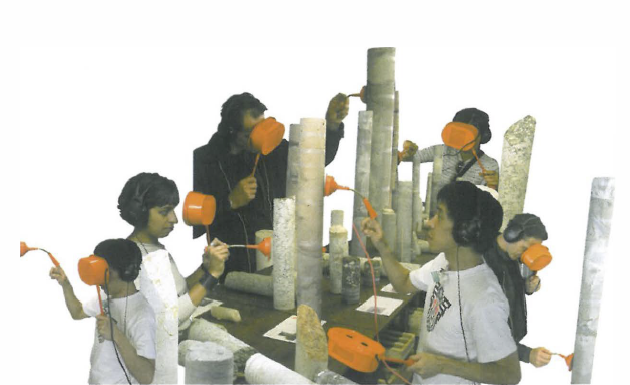
It is interesting to compare this second BEAP with its inaugural event. It was always going to be hard to match the excitement of a capacity crowd including students and non-arts professionals at the John Curtin Gallery, crushing their way into a spectacular blockbuster of leading electronic arts.
Following this flush of excitement the new 04 crowd has been dispersed into more than five shows. The volume and quality of material is there, it is just spread unevenly across the venues. Fortunately, the presence of international electronic artists has continued and once again they are playing a major role in the interaction around the event that makes BEAP so valuable.
This time, for me, two of the smaller shows provide the richest experience. The most memorable occurred at the opening of DistributedDifference: Cultures of Conflict at The Bank, Midland. Someone knocked over a perspex house containing a scurrying electronic rodent, part of an installation by Fernando Orellana (USA), entitled 8520 S.W 27th PLACE. [ILLUS] And Our collective instinct was to gasp with fear that this 'thing' had escaped, at the potential destruction of the artwork and a potentially life-ending moment for the rodent. Someone yelled out – 'don't worry the artist is here' – and the rodent was quickly rehoused, no damage done. It was a fabulously appropriate, unplanned, performance.
The audience betrayed its fears and hang-ups with the preciousness of art, of life and death and the fear of the unknown. In response we got the artist as saviour. The response echoed electronic arts discourse that we need artists to examine new technologies and thereby protect us from unfettered science. Oh Artists!
In addition to the rodents, this show gives us other life-forms, elfins, created and exposed with technology in Elf-Scan by Agnes Meyer-Brandis (Germany). [ILLUS] And with deft curating, David Crawford's (USA) multi-projection installation Stop Motion Studies – Tokyo Dreamers shows humans mediated by technology, caught in an environment of our own making, present and yet not. Here the visual technology poetically reflects and moves at a pace that we intuitively already know. This extension of the frozen moment is familiar. The stop, start, closeness and distance to others as experienced on public transport.
Works like Crawford's that use aesthetic means to explore the psychological and phenomenological impacts of technology are few and far between. The paintings by local artist Paul Uhlmann in Drift, a BEAP associated exhibition at PICA, cut through the dross of illustrating scientific principles. The only paintings in BEAP 04, they are stunning for their capturing of contemporary visual experience. Blurry, speedy, gritty, they are new but achingly familiar. How ironic they are made of paint!
Sensitive curating is also evident in SonicDifference: Resounding the World. The first exhibit is a silent one by Garth Paine; Endangered Sounds. Visitors are asked to record sounds they no longer hear. The clinking of milk bottles was a common one. Having attuned us to lost pleasures and the intimacy of the sonic world we move to sealed vacuum jars. The jars contain devices making patented and trademarked noises, none of which we can hear. I hadn't realised that sounds, such as Tarzan's holler, could be trademarked and patented. It is kind of weird, and to demonstrate the absurdity, Paine asks us to seal a patented noise into a test tube. How is such a patent to be policed? It is therefore pleasant to feel back in-control of one's aural universe and be able to play with Shawn Decker's (USA) A Small Migration. Lengths of piano wire above us respond to our movement for the wires are arrayed with small striker motors.
Simo Alitalo (Finland) with Viileaa (Sounds cool) tunes us into the wider environment with a haunting soundscape of Beluga whales, birds and icy weather. From the macro to the micro, Amy Youngs' (USA) Intraterrestrial Soundings amplifies noises from earthworms. A camera projects their wriggly bodies onto a screen above us, confirming the live-status of the worm participants. It feels a privilege to hear these hidden sounds.
For audiences already familiar with SimCity and Tamagotchis, lame games and illustrated scientific research do not cut it. But BEAP 04 has helped identify a few more artist heroes, and better still some anti-heroes like Crawford, Uhlmann, Alitalo and Youngs.












